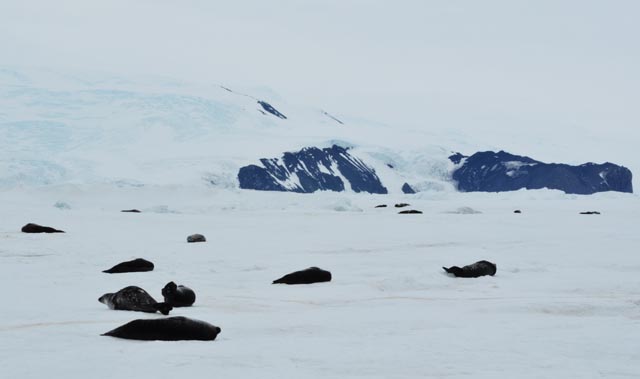|
Getting olderWeddell seals show only subtle signs of aging despite harsh environmentPosted February 1, 2013
Before they tried to answer the question of whether seals get cold, scientists studying the physiology of Weddell seals in Antarctica had a different puzzle in mind. Do seals get old? The answer: sort of. “The problem with marine mammals is that you don’t see old individuals,” explained Jo-Ann Mellish Of course, every mammal ages. Yet older seals are nearly physically indistinguishable, except for maybe worn-down teeth, from their younger cohorts. The mystery is even deeper in the case of the world’s southernmost pinniped because of their particular behavior. Weddell seals are extreme athletes, capable of diving to depths of 750 meters. In some cases, they can hold their breath for more than an hour. Such physical feats of prowess would normally come at a high price due to prolonged periods of hypoxia. The oxidative stress caused by extended dives of low oxygen followed by sudden re-oxygenation can case major cellular damage. In essence, they should show signs of aging faster than normal. How to determine if that’s the case or not? “We resorted to telemetry that was custom built,” said co-principal investigator Markus Horning Instead of the heat flux sensors used by the team on its current project to determine whether seals get cold (or, possibly, overheat), the scientists outfitted a number of the animals with electrocardiograms to measure heart rate while they swam. “We couldn’t put a seal on a treadmill. Instead, we put a little drag device on the animal,” Horning said. After capturing baseline physical activity data for about a week, the team recaptured the seals and added a device to increase the drag on the animals while they’re swimming. That meant the seals had to work a little harder to swim at the same speeds. Analysis is still under way on any behavioral differences between age cohorts. In addition to the virtual treadmill tests, the researchers collected blood and muscle samples. The blood chemistry showed some subtle differences between older and younger animals that might suggest miniscule organ deterioration, according to Mellish, a research associate professor at the University of Alaska Fairbanks However, team biologist Allyson Hindle’s analysis of the muscle tissue did discover stiffer collagen fibers, meaning the older animals probably did have to work harder than their younger and spryer counterparts. “It was the first definitive sign of aging that we were able to document in these animals,” Mellish said. NSF-funded research in this story: Markus Horning, Oregon State University, Award No. 0649609; Jo-Ann Mellish Return to main story — Cold enough for you? |



For USAP Participants |
For The Public |
For Researchers and EducatorsContact UsU.S. National Science FoundationOffice of Polar Programs Geosciences Directorate 2415 Eisenhower Avenue, Suite W7100 Alexandria, VA 22314 Sign up for the NSF Office of Polar Programs newsletter and events. Feedback Form |



